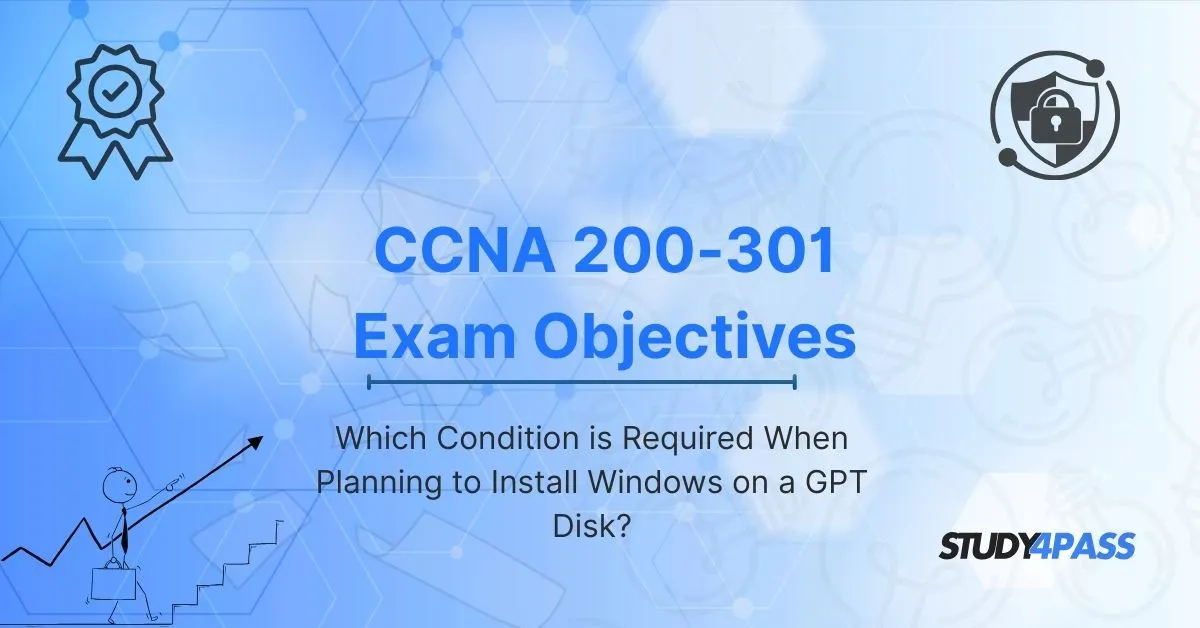Introduction To CCNA 200-301 Exam Objectives
The CCNA 200-301 exam is a pivotal step for aspiring network professionals, demanding a comprehensive understanding of various IT concepts. Among these, disk partitioning and file systems play a crucial role. Specifically, the ability to install Windows on a GPT (GUID Partition Table) disk is a critical skill, touching upon fundamental principles covered in the exam objectives.
Today, we'll delve into the necessary conditions for this process, while highlighting how Study4Pass can be your invaluable ally in mastering these concepts.
Understanding GPT and its Significance
Before we dive into the conditions for Windows installation, it's essential to understand what GPT is and why it's important. GPT is a partitioning scheme that replaces the older Master Boot Record (MBR) system. It offers several advantages, including support for larger disk sizes (beyond 2TB), a greater number of partitions, and improved data integrity.
The CCNA 200-301 Exam Objectives emphasize understanding storage concepts and operating system fundamentals. Knowing how to manage disks and file systems is crucial for network administrators, as they often deal with servers and workstations that require efficient and reliable storage solutions.
The Crucial Condition: UEFI Firmware
When planning to install Windows on a GPT disk, the most critical condition is the presence of UEFI (Unified Extensible Firmware Interface) firmware. UEFI is a modern firmware interface that replaces the traditional BIOS (Basic Input/Output System). It is essential for booting from GPT disks.
Here's why UEFI is indispensable:
GPT Support: UEFI natively supports GPT, allowing the system to recognize and boot from disks partitioned using this scheme. BIOS, on the other hand, is limited to MBR.
Secure Boot: UEFI offers Secure Boot, a feature that enhances system security by preventing the loading of unauthorized operating systems or drivers. This is particularly relevant in enterprise environments where security is paramount.
Larger Disk Support: As mentioned earlier, GPT supports disks larger than 2TB. UEFI is required to leverage this capability.
Other Considerations for Windows Installation on GPT
While UEFI is the primary requirement, other factors also play a role:
64-bit Windows: Windows operating systems installed on GPT disks must be 64-bit versions. 32-bit versions do not support booting from GPT.
Clean Installation: It's generally recommended to perform a clean installation of Windows on a GPT disk. Converting an existing MBR installation to GPT can be complex and may lead to data loss.
Driver Compatibility: Ensure that all hardware drivers are compatible with UEFI and the 64-bit version of Windows.
How Study4Pass Enhances Your CCNA 200-301 Preparation
Navigating the intricacies of disk partitioning and operating system installations can be challenging. This is where Study4Pass comes in. Study4Pass is a valuable resource that can significantly enhance your CCNA 200-301 Certification preparation.
Here's how Study4Pass can help you master the relevant concepts:
Comprehensive Study Materials: Study4Pass provides detailed study guides, practice questions, and exam simulations that cover all the CCNA 200-301 exam objectives, including storage and operating system fundamentals.
Real-World Scenarios: The platform offers real-world scenarios that allow you to apply your knowledge in practical situations. This helps you understand how the concepts relate to actual networking tasks.
Up-to-Date Content: Study4Pass ensures that its content is up-to-date with the latest exam objectives. This is crucial for staying ahead in the ever-evolving field of networking.
Expert Support: Study4Pass offers expert support to answer your questions and provide guidance throughout your preparation. This ensures that you have the resources you need to succeed.
Practice Tests: Study4Pass provides practice tests that mimic the actual CCNA 200-301 exam. This allows you to assess your progress and identify areas where you need to improve.
Detailed Explanations: Every question and topic provided by study4pass comes with detailed explanations. This allows the user to understand the reasoning behind the correct answer and to learn from their mistakes.
Cost effective: Study4pass provides these services at a cost effective price. This allows even the most budget conscious student to be able to study.
Connecting to the CCNA 200-301 Exam Objectives
The ability to install Windows on a GPT disk is directly relevant to several CCNA 200-301 exam objectives, including:
1.4 Explain storage concepts: This objective covers disk partitioning, file systems, and storage technologies, including GPT and UEFI.
1.6 Compare and contrast operating system characteristics (Windows, macOS, Linux): Understanding the requirements for installing Windows on different disk types is essential for this objective.
6.0 Security Fundamentals: Understanding secure boot, which is a UEFI feature, is critical to this objective.
Conclusion
In summary, the crucial condition for installing Windows on a GPT disk is the presence of UEFI firmware. This, along with other considerations such as 64-bit Windows and driver compatibility, ensures a successful installation.Mastering these concepts is essential for success in the CCNA 200-301 exam and for building a solid foundation in networking.
Special Discount: Offer Valid For Limited Time “Cisco 200-301 Exam Prep Practice Tests”
Actual exam question from Cisco's 200-301 Exam.
Sample Questions for Cisco 200-301 Exam Prep Practice Test
What is the function of VLAN in networking?
a) Increase broadcast domain size
b) Provide Layer 3 routing functionality
c) Create a logical separation of networks within the same physical network
d) Extend the reach of a single IP subnet
In IPv6, what is the length of the address?
a) 32 bits
b) 64 bits
c) 128 bits
d) 256 bits
Which of the following protocols is used to resolve IP addresses to MAC addresses in a local network?
a) ARP
b) DNS
c) HTTP
d) DHCP
What is the default administrative distance of a directly connected network in Cisco routers?
a) 0
b) 1
c) 90
d) 110
Which layer of the OSI model is responsible for routing packets between devices on different networks?
a) Application
b) Network
c) Data Link
d) Transport


